Legal Medical Marijuana Dispensary Owner Danny Trevino Sentenced Today to 15 Years in Federal Court1/28/2020 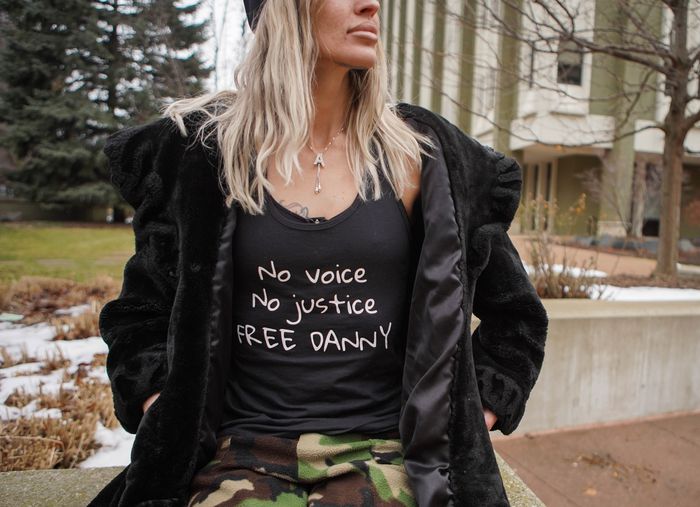 Activists gather to protest the sentencing of Danny Trevino Sydney Krey poses for a photo wearing a shirt she made in support of Danny Trevino at his sentencing at the Gerald R. Ford Federal Courthouse in Grand Rapids on Tuesday, Jan. 28, 2020. Krey, an activist, was there to protest the imprisonment of Trevino. Michigan medical cannabis dispensary owner Danny Trevino was sentenced in Federal Court today to 15 years in federal prison. Danny was convicted of violating federal as an owner of a medical cannabis dispensary that was operating legally under Michigan state law. This is a continuing story
The United States Department of Justice isn't supposed to be wasting tax dollars prosecuting marijuana crimes that are otherwise legal under state laws. However, it seems that even now if they feel a business operator has stepped out of bounds in some way, they will swoop in and remind us all that federal law is above any law passed by individual state governments. Michigan dispensary owner Danny Trevino (of Lansing) has finally reached sentencing for the charges he faced for the operation of his Hydroworld shops in Lansing, Grand Rapids, Jackson, Flint and Mount Pleasant and the judge gave him a total of 15 years and 8 months in federal prison. “States are changing marijuana laws across the country, certainly that's true, but federal law has not changed,” U.S. District Judge Paul Maloney said. Trevino was convicted of 10 felony charges, including conspiracy to manufacture, distribute and possess marijuana and maintaining a drug-involved premises. Throughout the trial, he was not allowed to use the Michigan state marijuana laws as a defense against the federal charges though he maintains that he was operating within state law. While he was arrested in 2014 in Grand Rapids for delivery or manufacturing of marijuana and maintaining a drug house, the charges were dropped a month later. Later, he fought the forfeiture of funds seized by the police. He eventually won that battle, and his money was returned by the state. His businesses saw 16 raids between 2010 and 2016, but each time he was able to provide the state with both store records and tax records. Even with the state's cloudy medical marijuana regulations at the time, it appears he attempted to remain compliant with those laws. Considering the fact that he was cleared of charges at the state level, you would think the federal government would step back. Instead, Assistant U.S. Attorney Daniel McGraw says that Trevino knew he was acting illegally under federal law and basically, that's all that matters. This is a case that didn't need to be seen by a judge as there are far more important things that the court system needs to worry about. The state didn't take the time to seek a conviction, and the Department of Justice had no need to step in and get involved. However, this is certainly a reminder that even for state-legal businesses, there remains some risk from federal interference if you don't comply with state law in every single aspect.
14 Comments
Early Portrait of Crispus Attucks (c) Learning CompanyHistorians know little about Crispus Attucks, and they have constructed accounts of his life more from speculation than facts. Most documents described his ancestry as African and American Indian. His father, Prince Yonger, is thought to have been a slave brought to America from Africa and that his mother, Nancy Attucks, was a Natick Indian. The family, which may have included an older sister named Phebe, lived in Framingham, Massachusetts. Apparently, young Attucks developed a longing for freedom at an early age. According to The Black Presence in the Era of the American Revolution, historians believe that an advertisement placed in the Boston Gazette on October 2, 1750, referred to him: “Ran away from his Master William Brown from Framingham, on the 30th of Sept. last, a Molatto Fellow, about 27 Years of age, named Crispas, 6 Feet two Inches high, short curl’d Hair, his Knees nearer together than common: had on a light colour’d Bearskin Coat.” The owner offered a reward of ten pounds for the return of the slave and warned ship captains against giving him refuge. Biographers believe that Attucks escaped to Nantucket, Massachusetts, and sailed as a harpooner on a whaling ship. Some writers proposed that he was using the name Michael Johnson. Attucks’ occupation made him particularly vulnerable to the presence of the British. As a seaman, he felt the ever-present danger of impressment into the British navy. As a laborer, he felt the competition from British troops, who often took part-time jobs during their off-duty hours and worked for lower wages. Historians definitely place Attucks in Boston in March of 1770. Assuming that the Boston Gazette advertisement did refer to him, he would have been about 47-years old. A fight between Boston rope makers and three British soldiers on Friday, March 2, 1770 set the stage for a later confrontation. After dusk on Monday, March 5, 1770, a crowd of colonists confronted a sentry who had struck a boy for complaining that an officer was late in paying a barber bill. As anger escalated, a church bell rang, which drew people out of their homes. The British soldiers of the 29th Regiment of Foot were called to duty. In turn, townspeople responded by hurling snowballs and debris at the soldiers. A group of men led by Attucks approached the vicinity of the government building with clubs in hand. Violence soon erupted, and a soldier was struck with a thrown piece of wood. Some accounts named Attucks as the person responsible. Other witnesses stated that Attucks was “leaning upon a stick” when the soldiers opened fire. Five Americans were killed and six were wounded in what came to be called the Boston Massacre. Attucks was the first one killed; he took two bullets in the chest. Rope maker Samuel Gray and sailor James Caldwell also died in the incident. Samuel Maverick, a 17-year-old joiner’s apprentice, died the next day. Irish leather worker Patrick Carr died nine days later. Attucks’ body was carried to Faneuil Hall, where it lay in state until Thursday, March 8, when he and the other victims were buried together. Martin Luther King, Jr., referred to Crispus Attucks in the introduction of Why We Can’t Wait (1964) as an example of a man whose contribution to history, though much-overlooked by standard histories, provided a potent message of moral courage. In an unsourced book that appealed to a wide audience, James Neyland wrote his appraisal of Attucks’s significance: He is one of the most important figures in African-American history, not for what he did for his own race but for what he did for all oppressed people everywhere. He is a reminder that the African-American heritage is not only African but American and it is a heritage that begins with the beginning of America. Crispus Attucks became the first casualty of the American Revolution when he was shot and killed. Although Attucks was credited as the leader and instigator of the event, debate raged for over a century as to whether he was a hero and a patriot, or a rabble-rousing villain. The debate notwithstanding, Attucks, immortalized as “the first to defy, the first to die,” has been lauded as a true martyr, “the first to pour out his blood as a precious libation on the altar of a people’s rights.” At a congressional hearing Wednesday, federal regulators recognized that valuable research into marijuana is being inhibited by cannabis’s current legal status and described previously unreported steps they’re taking to resolve the issue. The Energy and Commerce Subcommittee on Health held the meeting to discuss six cannabis reform proposals, including two that would federally legalize marijuana. Most of the hearing involved lawmakers pressing witnesses from the Drug Enforcement Administration (DEA), Food and Drug Administration (FDA), and National Institute on Drug Abuse (NIDA) on the obstacles to marijuana studies that those officials claim are needed before pursuing broader policy reform. Conversation was more limited when it came to legalization bills such as Judiciary Chairman Jerrod Nadler’s Marijuana Opportunity, Reinvestment, and Expungement (MORE) Act, which was approved by his panel last year. That said, formerly anti-reform Representative Joe Kennedy III did lead a powerful discussion about the failures of prohibition and the need to deschedule cannabis. Kennedy announced that panel leadership has agreed to hold a second hearing featuring the voices of people negatively impacted by marijuana prohibition, which he said “has failed.” Energy and Commerce Committee Chairman Frank Pallone said in his opening statement that “while state laws and public perception around cannabis and its derivatives have evolved over the years, much of the federal framework that regulates cannabis has stayed the same.” Rep. Frank Pallone✔@FrankPalloneToday the @EnergyCommerce Health Subcommittee is holding a legislative hearing on cannabis policies for the new decade including proposals to decriminalize marijuana and increase important research on cannabis, hemp and CBD. After being repeatedly asked about the limited supply of research-grade cannabis and the lack of chemical diversity in those plants cultivated at the nation’s only federally authorized manufacturer, DEA Senior Policy Advisor Matthew Strait said the agency is aware of the issue and is actively developing regulations to address the problem by licensing additional growers. “We actually have a draft regulation in place,” he said, adding that it’s currently being reviewed by the White House Office of Management and Budget and that regulators have a call scheduled for Thursday to discuss the proposed rule. “We know that we have to probably do notice and comment rulemaking to implement regulations on two matters: one is how we’re going to evaluate all of our pending applications and two what additional types of regulations might need to be in place in order to impose on those that would grow,” he said. “That regulation is in draft form. I can’t talk too much about it, but rest assured, we have submitted to OMB, it’s been drafted and tomorrow some of us will be getting on a call to talk through it.” The DEA, FDA, and NIDA witnesses all agreed under questioning that the current supply of cannabis for study purposes is inadequate and that researchers should be able to access a wider range of marijuana products. Kennedy, who recently became a cosponsor of the MORE Act, followed up on his opening remarks with a brief statement on his personal evolution on the issue and frustration over policies inhibiting research. “Meanwhile, millions of Americans — mostly black and brown — have been locked up for non-violent drug offenses. Meanwhile, desperate parents are forced to turn to a black market with no concern for patient safety to get their children the relief that they need. Meanwhile our cities and states are trying, and at times stumbling, to put in place thoughtful and thorough regulatory frameworks with zero support from federal partners. And meanwhile, a brand new corporate industry is rising up, rife with predictable economic injustices that spring up whenever government fails to regulate. Prohibition has clearly failed and America isn’t waiting for its government anymore.” He then asked NIDA Director Nora Volkow and FDA Deputy Director for Regulatory Programs Douglas Throckmorton whether removing cannabis from the Controlled Substances Act would make it easier for researchers to obtain and study it. Both said that the policy change would in fact simplify research, though Volkow said it “may have unintended negative consequences.” FDA and NIDA said their agencies would not be impacted if marijuana was descheduled, and DEA’s Strait acknowledged that his agency would because of its responsibility to enforce the CSA. Subcommittee Chairwoman Anna Eshoo said researchers are “are in a catch-22” under the current regulatory scheme because they “can’t conduct research until they show cannabis has a medical use, but they can’t demonstrate cannabis has a medical use until they can conduct research.” “It doesn’t make sense — at least to me,” she said. Representative Tony Cardenas said that the “United States Congress made a mistake, and every Congress since has not had honest hearings and honest dialogue and has not allowed — truly allowed — the researchers in this great country to do the true research that needs to be done for us to properly categorize cannabis in this country.” “As a result of that, we have millions of individuals in this country who have been subjected to incarceration and a criminal record that otherwise they would have a much more productive and better life and that as a society, we would be much better off, including the taxpayers, if we were to actually get this right,” he said. Read the full story on Marijuana Moment. 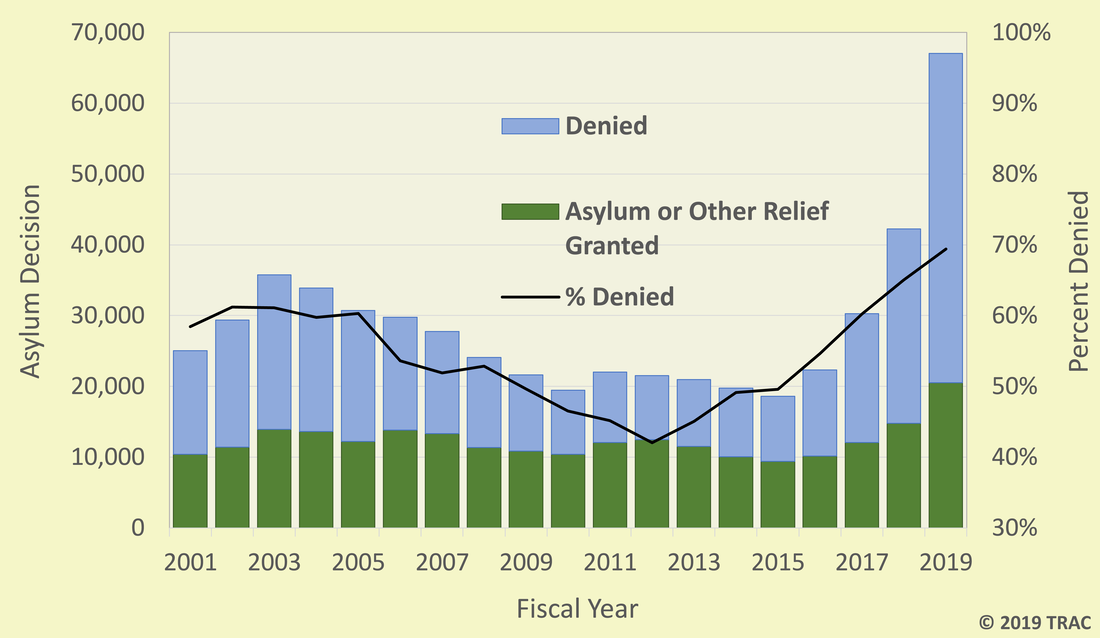 Immigration judges decided a record number of asylum cases in FY 2019. This past year judges decided 67,406 asylum cases, nearly two-and-a-half times the number from five years ago when judges decided 19,779 asylum cases. Asylum decisions also make up an increasing proportion of the Immigration Court's workload. Nearly one in four cases (22.6%) that judges decided were asylum claims in FY 2019, up from one in ten (10.7%) back in FY 2014. The number of immigrants who have been granted asylum more than doubled from 9,684 in FY 2014 to 19,831 in FY 2019. However, the number of immigrants who have been denied asylum or other relief grew even faster from 9,716 immigrants to 46,735 over the same time period. Six-nine percent (69%) of asylum seekers were denied asylum or other relief in 2019. See Figure 1 Figure 1. Immigration Court Asylum Decisions by Outcome, 2001 - 2019 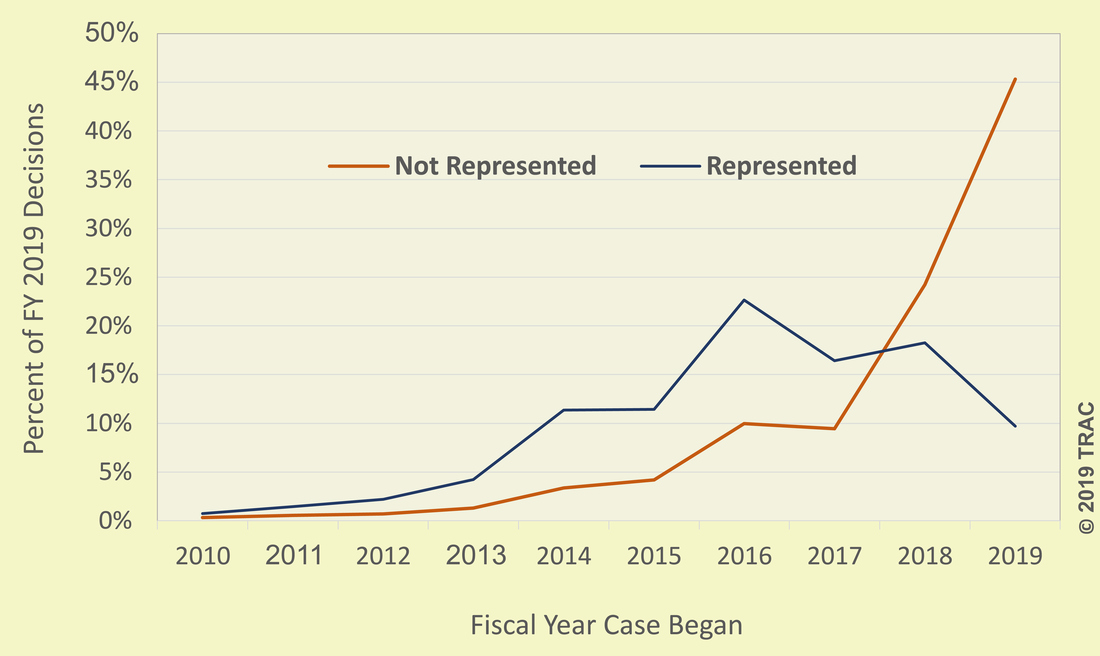 Wait Times, Representation, and Denial Rates Overall, asylum applicants waited on average 1,030 days - or nearly three years - for their cases to be decided. But many asylum applicants waited even longer: a quarter of applicants waited 1,421 days, or nearly four years, for their asylum decision. Not surprisingly, applicants who were not represented by an attorney and thus less able to present an effective case received a faster decision than those applicants who did have an attorney. Figure 2 compares represented and non-represented asylum cases. Although all of the cases included in the graph were concluded in FY 2019, the graph shows the year each case began, which provides insight into the impact attorney representation plays on the speed of asylum cases. For instance, nearly half (45.3%) of the unrepresented asylum cases that began in 2019 have already been decided. In contrast, less than one in ten (9.7%) of the represented asylum cases that began in 2019 have been decided. Figure 2. 2019 Asylum Decisions by When Case Began 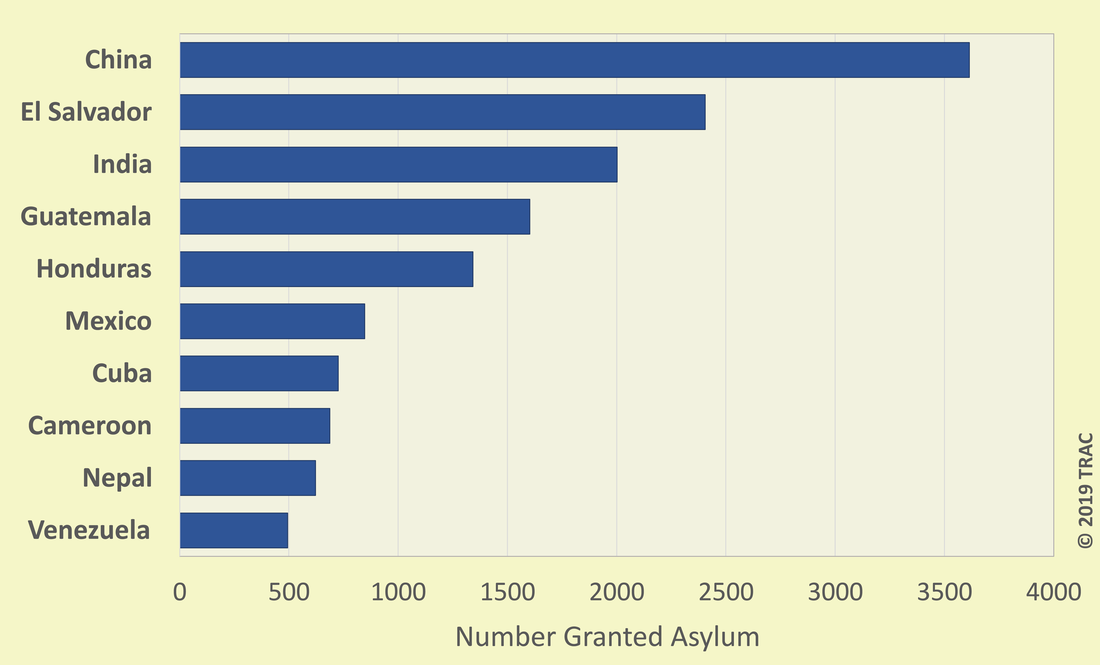 Access to an attorney also impacts the outcome of asylum cases. Only 16 percent of unrepresented asylum applicants received asylum or other forms of deportation relief. In contrast, twice the proportion (33%) of asylum applicants with an attorney received asylum or other relief. Asylum Decisions by NationalityMore Chinese nationals were granted asylum than any other nationality. Immigration judges granted asylum to 3,623 Chinese nationals in FY 2019. Despite fewer applicants compared to some other nationalities, a relatively low denial rate pushed their numbers to the top of the list. Chinese applicants were denied just 25 percent of the time compared with a 69 percent denial rate for asylum seekers generally. El Salvadorian nationals were granted asylum in 2,419 cases, and Indian nationals were granted asylum in 2,006 cases. Guatemala and Honduras had the fourth and fifth highest totals. Asylum seekers from Mexico, Cuba, Cameroon, Nepal, and Venezuela comprised the rest of the top ten nationalities receiving asylum grants during FY 2019. See Figure 3. Figure 3. Top 10 Nationalities Granted Asylum in 2019 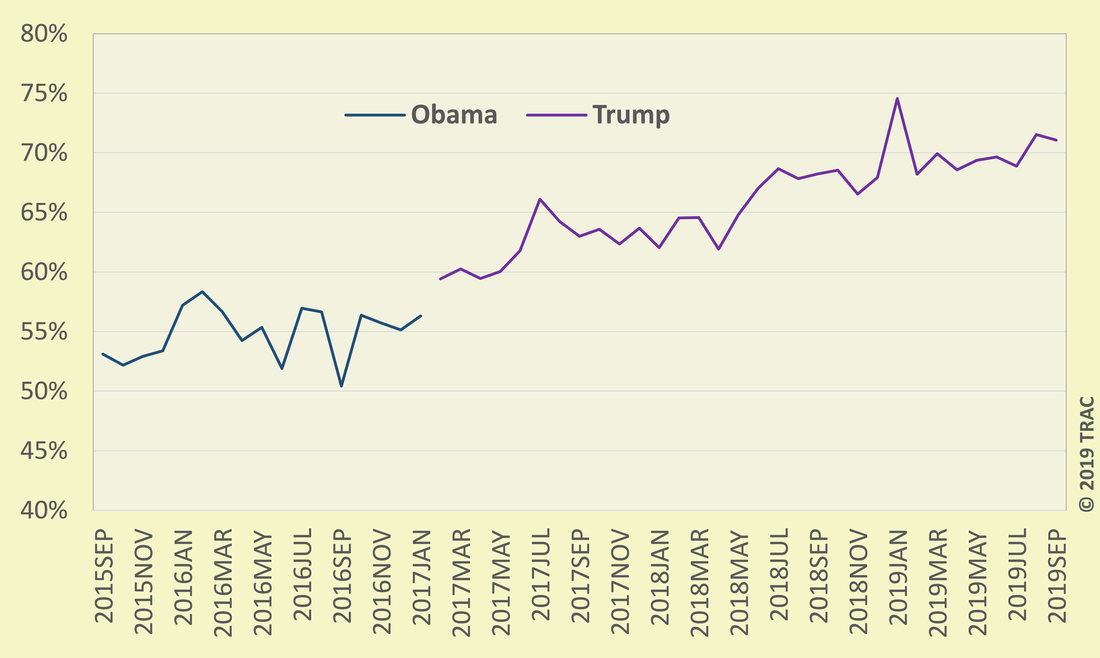 Recent Trends Under President Trump Organized efforts across the country to provide pro bono legal representation resulted in increasing rates of representation for asylum seekers. Despite the very large jump in asylum cases in FY 2019, representation rates continued to rise modestly. During FY 2019, 84.7 percent of cases with asylum decisions had representation continuing the rise from 76.2 percent five years ago, 77.9 percent two years ago, and 83.8 percent one year ago. With rare exception, asylum seekers whose cases were decided in FY 2019 also showed up for every court hearing. This was true even though four out of five immigrants were not detained or had been previously released from ICE custody. In fact, among non-detained asylum seekers, 99 out of 100 (98.7%) attended all their court hearings. While Figure 1 shows a fairly steady rise in asylum denial rates since FY 2015, the month-by month picture gives a more nuanced impression. Against a backdrop of natural month-to- month variability, Figure 4 shows that there were periods of relative increase followed by stretches where rates showed little average gain. The switch to a purple line from blue shown in Figure 4 marks where President Trump assumed office following President Obama. The graph indicates that asylum denial rates rose during the initial months of the Trump Administration, but stabilized shortly thereafter. Starting in June 2018, however, denials began climbing again after former Attorney General Sessions strictly limited the grounds on which immigration judges could grant asylum. Sessions unilaterally restricted the legal basis for asylum for Central American women and children fleeing from gang and domestic violence. The unusually high denial rate in January 2019 occurred during the federal government shutdown when the only asylum cases judges heard were for detained immigrants who were often unrepresented. Figure 4. Percent of Immigration Court Asylum Decisions Denied September 2015 - September 2019 Drilling Deeper Into Asylum Data
Users can drill in to examine, month-by-month, asylum decisions by court, hearing location, nationality, custody, representation status and more. The Asylum Decision app has been updated to cover every Immigration Court asylum decision from October 2000 through November 2019. |
HISTORY
April 2024
Categories |
© Walk 4 Change. All rights reserved.

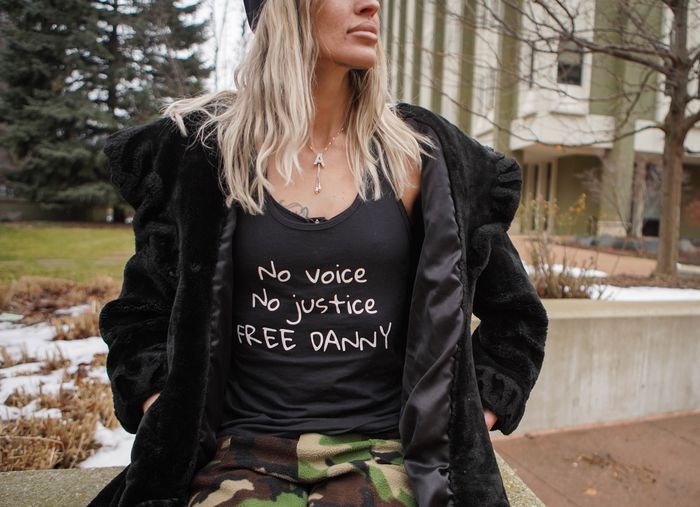
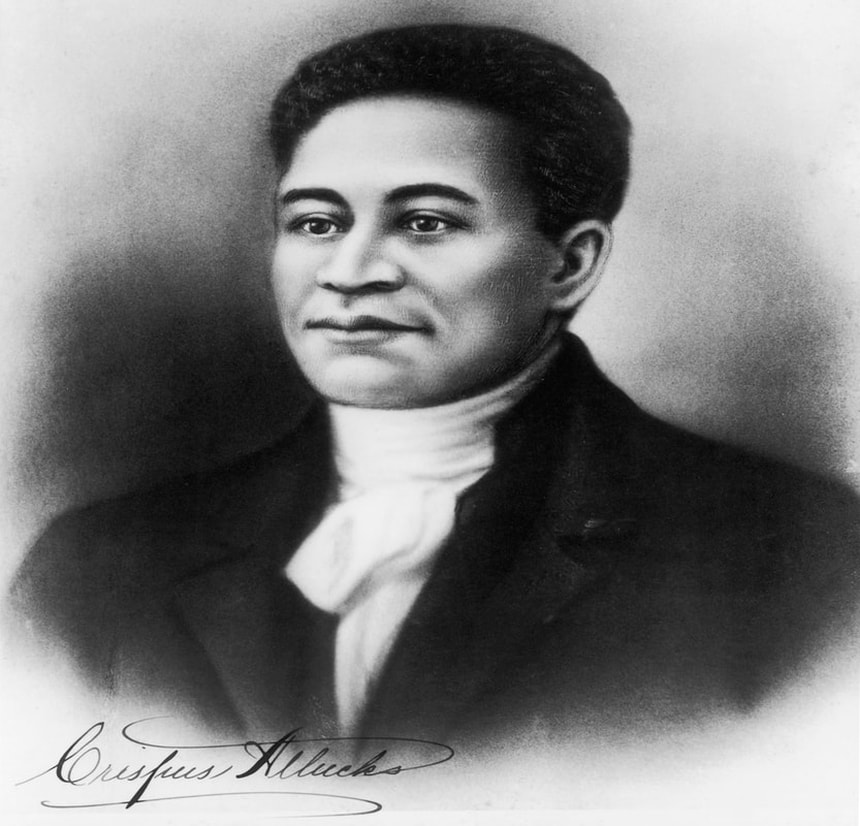
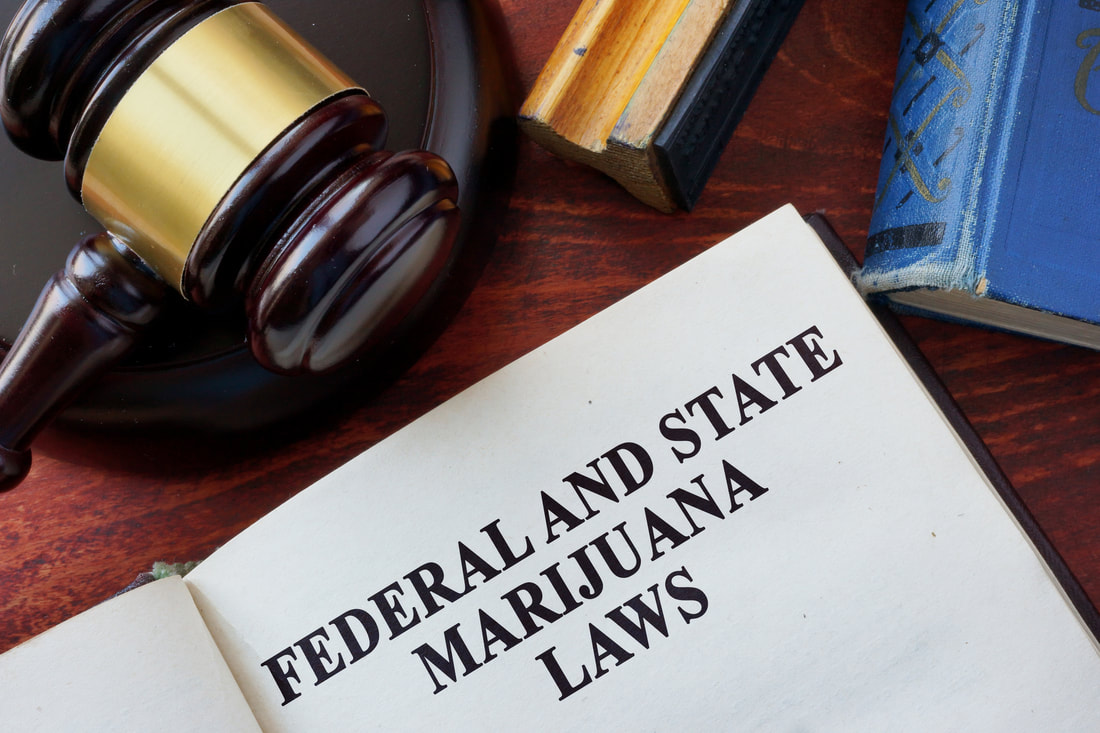

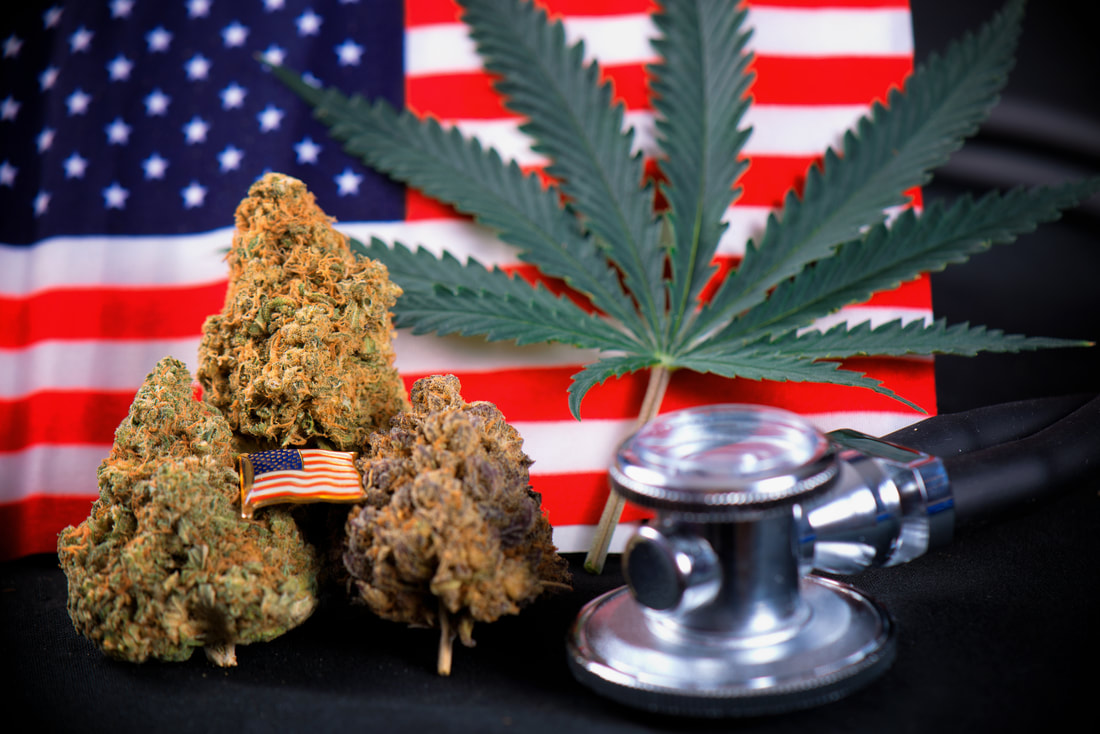
 RSS Feed
RSS Feed